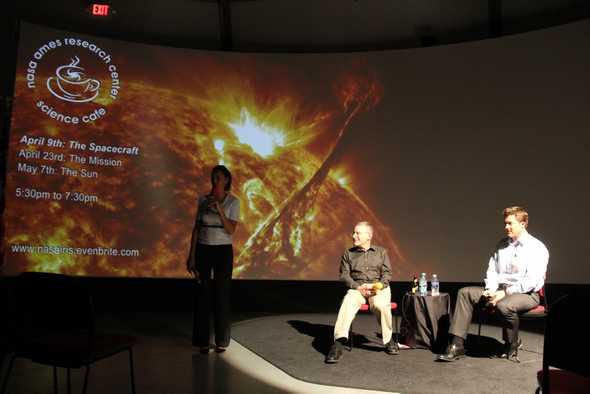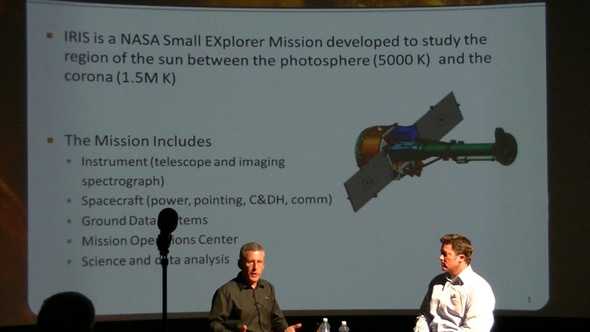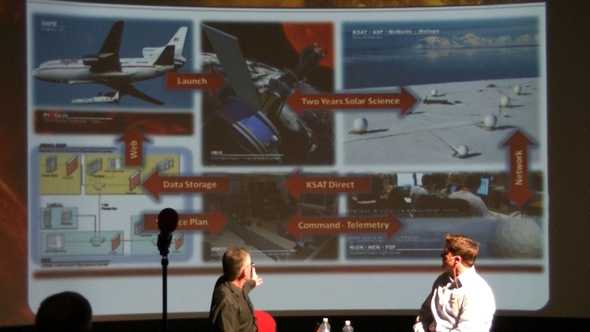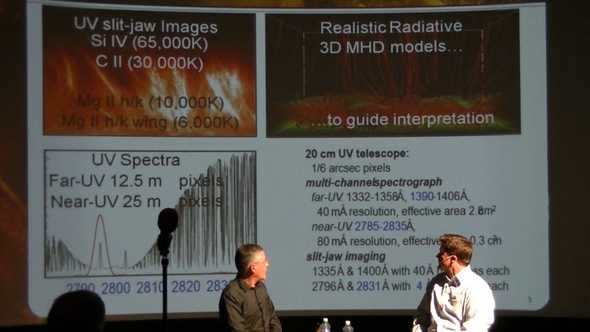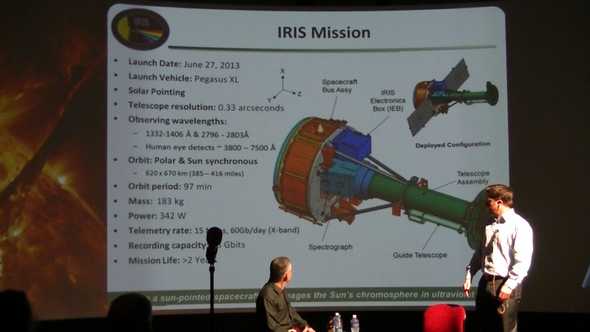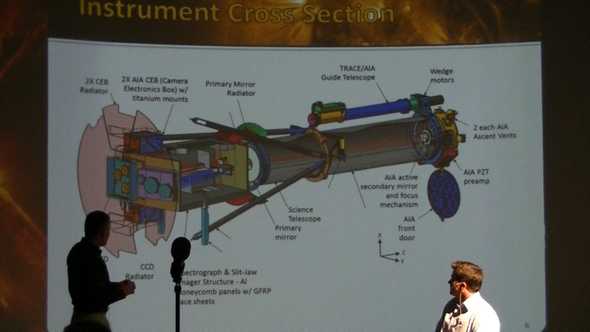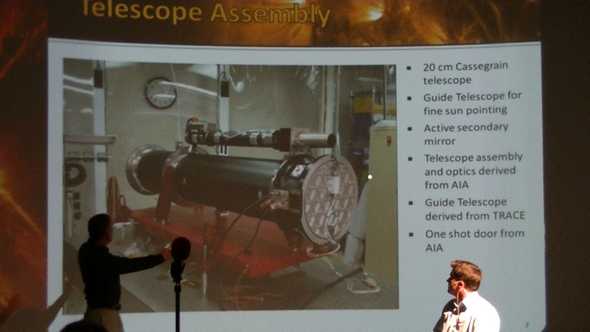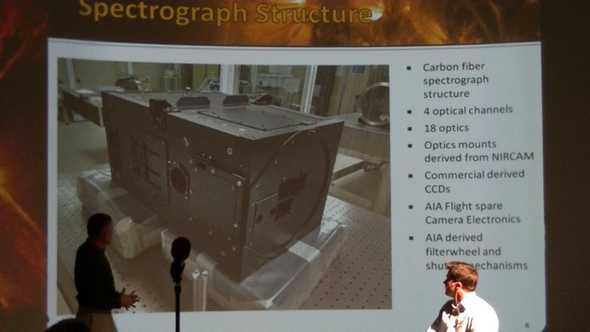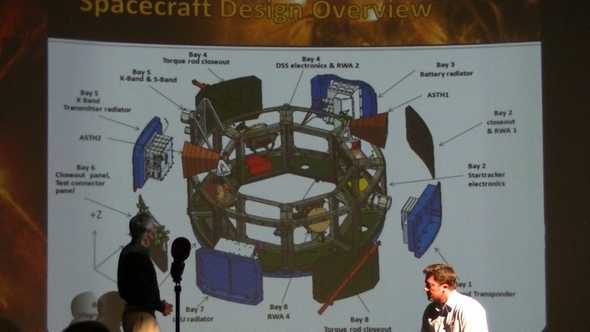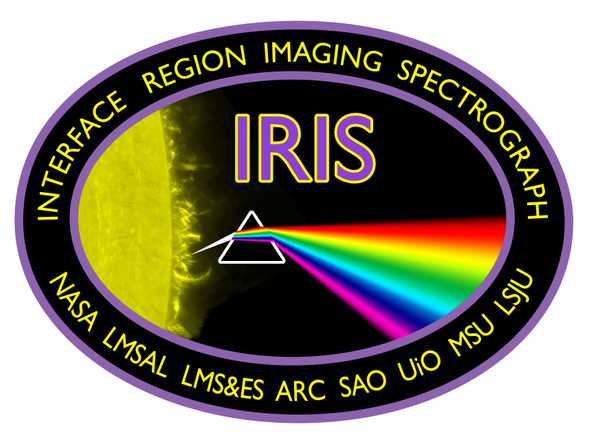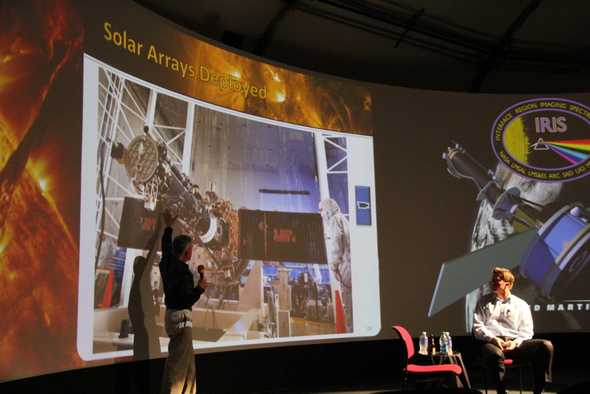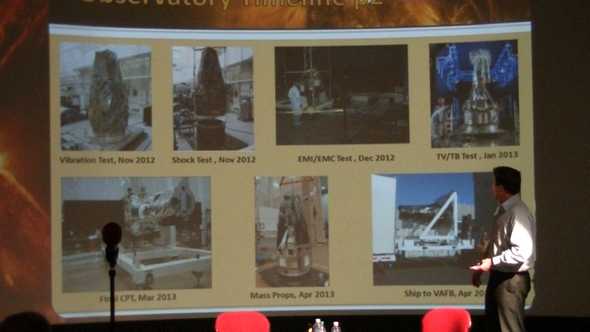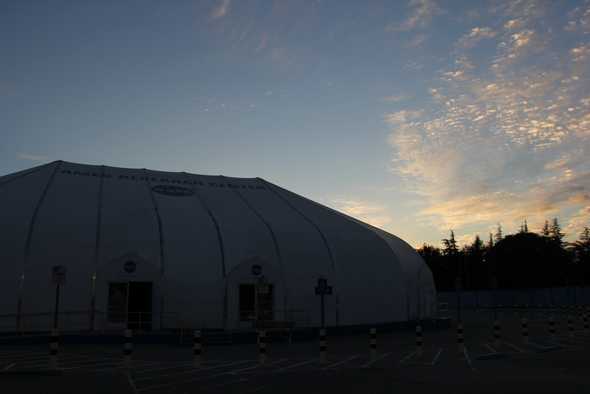IRIS Science Cafe: The Spacecraft
On Wednesday night NASA Ames hosted the first IRIS Science Cafe at the NASA Ames Visitor Center. The science cafe program was the first in a series of evening programs NASA Ames is piloting. The first program focused on the IRIS spacecraft and was led by Kimberly, Gary Kushner, and Chris Hoffman.
Gary Kushner is a program manager at Lockheed Martin. He was previously a program manager for the AIA instrument on the NASA Solar Dynamics Observatory, also known as SDO. He has also supported the Focul Plane package and Japan’s Hinode mission.
Chris Hoffman is also from Lockheed Martin. He is Chief Engineer on the IRIS mission. He has 21 years of experience in small satellite and payload system engineering. He has worked on six missions spanning from SMAPEX to FAST in 1996, SWOSS in 1998, TRACE in 1998, and Hinode in 2006.
Gary and Chris started off by giving an overview of the IRIS mission. IRIS is a NASA Small EXplorer Mission developed to study the region of the sun between the photosphere (5000 K) and the corona (1.5M K).
The mission includes the instrument, a telescope and imaging spectrograph; the spacecraft with power, pointing, C&DH, and comm; Ground Data Systems; Mission Operations Center; and science and data analysis.
The spacecraft is about seven feet tall and four feet wide at the base. It expands to twelve feet with the solar arrays deployed. IRIS is a science mission, answering questions from the science community.
IRIS communicates with a ground station located in Norway.
The imaging spectrograph can take images and spectra of the sun. They are interested in the region of the sun called the interface region. It is very dense region between the photosphere and the corona.
The sun’s temperature at the surface is about 5000 K. Out in the corona, or the atmosphere, the temperature is about a million Kelvin. One of the questions of interest is how the temperature can change so dramatically and why it does. Scientists are trying to understand how taking the magnetic fields at the surface convert into a lot of energy works in the corona.
The IRIS spacecraft launched in June 27th, 2013 on board a Pegasus XL launch vehicle. The telescope resolution is 0.33 arcseconds. The spacecraft is 183 kg, generates about 360 W of power, and uses 260 W (with a peak of 342 W) of power. The recording capacity is 48 Gbits, about one half of the smallest iPhone storage available today.
The mission life is at least two years, and they hope to extend to at least four if not up to ten years if funding is available.
Light from the sun enters the telescope and travels to the primary mirror located in the middle of the spacecraft. Light then travels to the spectrograph and is split into multiple channels. The multiple channels allows scientists to see different wavelengths of light.
The telescope is a 20 cm Cassegrain telescope. The assembly and optics were derived from Atmospheric Imaging Assembly (AIA) from NASA’s SDO mission. It has a guide telescope for fine sun pointing derived from the Transition Region and Coronal Explorer (TRACE) satellite.
The spectrograph is made of carbon fiber and has four optical channels and eighteen optics. The optics mounts were derived from the Near Infrared Camera (NIRCAM).
The integrated instrument has a primary mirror heat dump radiator (white ring) that ejects the heat from the sun.
The IAU, the main computer, is located in Bay 7. The transmitter that transmits the science data is located in Bay 5.
One of the unique things about IRIS is that it does not have a gyroscope. Unlike other telescopes that view a wider angle, IRIS points at only one thing, the sun. The sun sensor and guide telescope are all that is necessary to find the sun. Because they were able to remove some of the hardware, it reduced the cost.
The audience was then invited to ask questions. The following is a summary of what was asked.
What are the torque rods and how do they work?
The toque rods have two purposes. After separation from the Pegasus vehicle, they are used to dampen the tumbling. The spacecraft is tumbling at 2-4 degrees per second. Using the magnetometer, it can sense the change in the magnetic field. The torque rods are used as a braking force to slow the tumbling down.
The torque rods are also used to unload momentum from the reaction wheels during slew maneuvers.
Why was the Pegasus vehicle used?
It wasn’t mandatory to use the Pegasus vehicle. IRIS fit a small explorer profile and it ultimately cost less than launching on another vehicle like the Atlas. Once the mission is selected, NASA puts out a bid for a launch vehicle. The bid that best fits the mission is then selected.
The launch location, however, matters. Vadenburg is better for polar orbits. Launching from Kennedy Space Center in Florida usually is done for equatorial orbits.
Why was it launched from an aircraft?
By launching from an aircraft at 30,000-40,000 feet, you save fuel costs to get up to that height.
How much of the spacecraft is off the shelf hardware?
They have to meet some level of space qualification. NASA has different risk qualifications. Billion dollar missions like Hubble and the James Web Telescope are in the highest classification because they can never fail in orbit. IRIS is in Class C/Class D, which allows them to relax some of the standards. The torque rods, IAU, and most of the hardware is off the shelf and commercially available. The antennas are optimized for higher orbit.
What happens when there is a solar eclipse?
Because IRIS is 600 km above Earth’s surface, it doesn’t affect anything. IRIS just has a different perspective.
How do solar flares affect the spacecraft?
That’s what makes the team happy. If there is a big enough ejection, they might see some noise on their detectors. It doesn’t affect the health of the spacecraft.
Would IRIS be able to predict a coronal mass ejection?
The observatory would be able to observe it, but scientists would be the ones to predict it. Right now, they are advancing the data available for computer models to understand the sun. Hopefully they can get to the point of predicting ejections.
Have there been any significant hardware/software failures?
There haven’t been any failures. The spacecraft’s computer hasn’t even rebooted in almost a year. There have been interesting things learned about the star tracker. It picks up more light over Antarctica. They are improving the software to make performance better. But the updates are not required.
What is the data rate?
It is 2 KBits/second. Chris regrets that it isn’t 10-15 KBits/second. Getting an upload takes about 16 ten minute passes, about three hours over a week.
What are your backgrounds?
Chris started out in Mission Operations for IUE which launched in 1977. The new program Small Explorers was starting up and allowed him to get quick experience doing lots of different things relating to systems. His degree is in Aerospace Engineering.
Gary has a Bachelor degree in Physics from the University of Colorado. He was an intern putting together vacuum chambers, and helping grad students do their sounding rockets.
What does the mission patch represent?
The left side is the sun, with the sunlight being broken up into different wavelengths. They pick four wavelengths they want to study and put them on the CCDs.
What is a CCD?
A charge-coupled device. A CCD is an electronic semiconductor device that converts light into electrons that can then be read by computers. CCDs are also found in consumer cameras.
How long did it take to design the spacecraft?
NASA first announced plans for a new mission. NASA accepted proposals from the science community about what scientific questions could be studied if a proposal is chosen. For IRIS, NASA chose six people. That process started in 2007. It took two years between submitting a proposal and being accepted. Design started in September 2009. It takes about a year to receive funding. Because small spacecraft are faster, cheaper, and reuse a lot of stuff, the process takes less time. Time from design to launch was about 45 months.
Were there any open-source contributions from the community?
We use open source code for ground systems. The command and control systems developed by NASA Goddard are now open source. As far as the spacecraft, most of it is custom code or off the shelf that come with the hardware. The star tracker has its own code.
The spacecraft bus was made out of a large block of aluminum. Is that common?
The spacecraft bus was made out of a large five by four foot block of aluminum. A C&C machine carved it. If any part of the bus broke, they would have had to start over. The vendor said it was less expensive to machine one piece instead of bolting together parts. They had margins on the mass requirements and it was cheaper but heavier to do it this way.
Can you provide more details about the heat management?
Multi-layer insulation blankets made up of 13-15 layers of material provide the spacecraft protection. They want to keep the spacecraft at room temperature, about 70 degrees Fahrenheit. Little heaters made of foil and wires use power from the solar arrays to keep the telescope warm.
The CCDs need to be cold to reduce the amount of noise. Another radiator on the back side is facing deep space. It pulls heat from the CCDs to cool them down.
Were there any challenges with the Lithium-ion batteries?
Lithium-ion batteries are common in cellphones, laptop computers, even cars. This is the second or third spacecraft that Lockheed Martin has flown with Lithium-ion batteries. Other batteries with older technology need to remain at a specific temperature, to be discharged and charged carefully. Lithium-ion batteries have a high energy capacity and need to be handled carefully.
What types of testing do you do on the spacecraft?
After the instrument and spacecraft were mated in August 2012, they completed a functional Comprehensive Performance Test (CPT) in November 2012. The CPT tests every function that the spacecraft does and sets a baseline before they go into environmental testing.
They then perform vibration tests that tests the loads experienced from the Pegasus launch vehicle.
The launch team then performs a shock test. It is placed on the launch vehicle interface. There is a clamp band that has explosive bolts. The launch vehicle part falls off, exerting a force into the spacecraft.
In December 2012, the electromagnetic interference and electromagnetic compatibility tests checked that the spacecraft didn’t emit harmful frequencies to the launch vehicle that could affect the flight. The spacecraft was found to be pretty quiet.
In January 2013, a thermal vacuum test tested the hot and cold survival temperatures experienced on orbit. It goes through about eight cycles to qualify the hardware. Industry experts have concluded doing thermal tests reduce the chances of failures. Optimally, that number is about 12.
In March 2013, a final comprehensive performance test is performed. In April 2013, they weighed it and shipped it to Vandenburg Air Force Base in southern California.
How is IRIS similar and different from Hubble?
There are more differences than similarities. From an attitude control perspective, they have some similar components. Both have four reaction wheels that point to anywhere in three-axis space. Hubble has a gyro pack that allows Hubble to slew anywhere in the universe. IRIS can only point to the sun. Both have star trackers to update their attitudes. Both have magnetometers that sense Earth’s magnetic field. And Hubble cost twenty thousand times more than IRIS did.
What languages and software is used?
About nine people were involved in writing the software, with others contributing parts. C++ and a modeling language that was converted into flight code were the primary languages used. Python is used to transfer the data between NASA Ames and Stanford. Software from the NASA SDO mission is also used to process the data. And individual scientists have other software to extract data.
Who in the Bay Area was involved in the mission?
The Palo Alto group participated in building the spacecraft. Lockheed Martin in Sunnyvale built the solar arrays and spacecraft bus. The insulation blankets were made in Fremont. The antenna was designed by a group at NASA Ames and fabricated in Arizona.
There are two upcoming science cafes coming up in the next month. Interested adults 21+ can register here.

